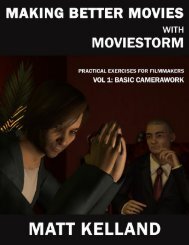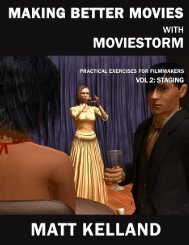Making Better Movies with Moviestorm Vol 3: Sound and Light
Making Better Movies with Moviestorm Vol 3: Sound and Light
Making Better Movies with Moviestorm Vol 3: Sound and Light
Create successful ePaper yourself
Turn your PDF publications into a flip-book with our unique Google optimized e-Paper software.
AMBIENT NOISE<br />
Technique<br />
Experiment <strong>with</strong> adding different amounts of ambient noise to a scene.<br />
Ambient noise, also known as "atmos" or background", or simply "ambience", is all the sounds that are naturally<br />
made by the environment.<br />
When adding ambience, you can be very flexible <strong>with</strong> how much you add. This is mostly a stylistic choice. It is<br />
something that you can simply leave to the sound designer, but it helps to be aware of this while shooting, as it gives<br />
you a better idea of how the finished scene will play <strong>and</strong> the mood you are creating.<br />
In some cases, particularly action scenes, it can be good to have the ambience so loud <strong>and</strong> complex that they take<br />
over, but you need to ensure the audience can follow the important parts of the story.<br />
Left: a scene in a busy office, <strong>with</strong> people talking, making phone calls, <strong>and</strong> using computers. Right: in this<br />
action scene, you have explosions <strong>and</strong> gunfire, as well as people running through trees <strong>and</strong> undergrowth <strong>and</strong><br />
shouting. The ambient sounds add to the setting, but can quickly become distracting.<br />
Use a scene in a moderately busy location – either interior or exterior. Ideally, it<br />
should be 1-2 minutes long, including 2 or more people. Scenes <strong>with</strong> some dialog<br />
work best for this.<br />
11




